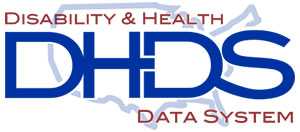Disability and Health Data System (DHDS)

Visit Disability and Health Data System to find information about the health and wellness of adults with disabilities.
Disability and Health Data System (DHDS) is an online source of state-level data on adults with disabilities. Users can access information on five functional disability types*: cognitive (serious difficulty concentrating, remembering or making decisions), mobility (serious difficulty walking or climbing stairs), vision (serious difficulty seeing), self-care (difficulty dressing or bathing) and independent living (difficulty doing errands alone). Information on limitation status (use of special equipment or activity limitation because of physical, mental, or emotional problems) is also available.
Data on more than 30 health topics among adults with or without disabilities can be explored in DHDS, including smoking, physical activity, obesity, hypertension, heart disease, and diabetes.
Users can customize the data they want to view, making it easy to see information about their state or region. They can identify health differences between adults with and without disabilities overall, and by age, sex, and race/ethnicity.
Health Indicator List
With DHDS, you can answer questions such as
- What is the percentage of adults with disabilities in each state?
- What is the percentage of adults with select functional disability types in each state?
- How does the percentage of adults with disabilities vary by age, sex, and race/ethnicity in each state?
- How does the state percentage compare with the national percentage?
- How does it compare to neighboring states?
- Does the percentage of adults who are obese vary across different functional disability types?
- How does a particular state perform across a variety of healthcare indicators, such as flu vaccine coverage and doctor visits, for adults with disabilities compared with adults without disabilities?
- In a particular state, is the percentage of adults who currently smoke cigarettes higher among adults with mobility disability than among adults with cognitive disability?
- What state has the highest percentage of adults with disabilities who could not see a doctor due to cost?
You can use DHDS to
- Identify differences in key health indicators between adults with select functional disability types.
- Identify data patterns across the country using colorful interactive maps.
- Download PDFs, maps, and customized data tables to use in presentations, reports, or grant applications.
- Gather state-specific data to inform decision-makers about the health differences between adults with and without disabilities in their state.
Spread the Word
You can become an advocate for health by posting a button or badge to your website, blog, or social networking site (e.g., Facebook page).
To get the embed code, click on the image. Then click “</>” on the top left of the image.
*In 2013 and 2014, the Behavioral Risk Factor Surveillance System (BRFSS), which is the DHDS data source, did not ask participants about deafness or serious difficulty hearing (as referred to in some sections of DHDS as “hearing disability”). Therefore, this data is not included in DHDS at this time. However, BRFSS began collecting this information in 2016.
- Page last reviewed: August 3, 2017
- Page last updated: August 3, 2017
- Content source:




 ShareCompartir
ShareCompartir